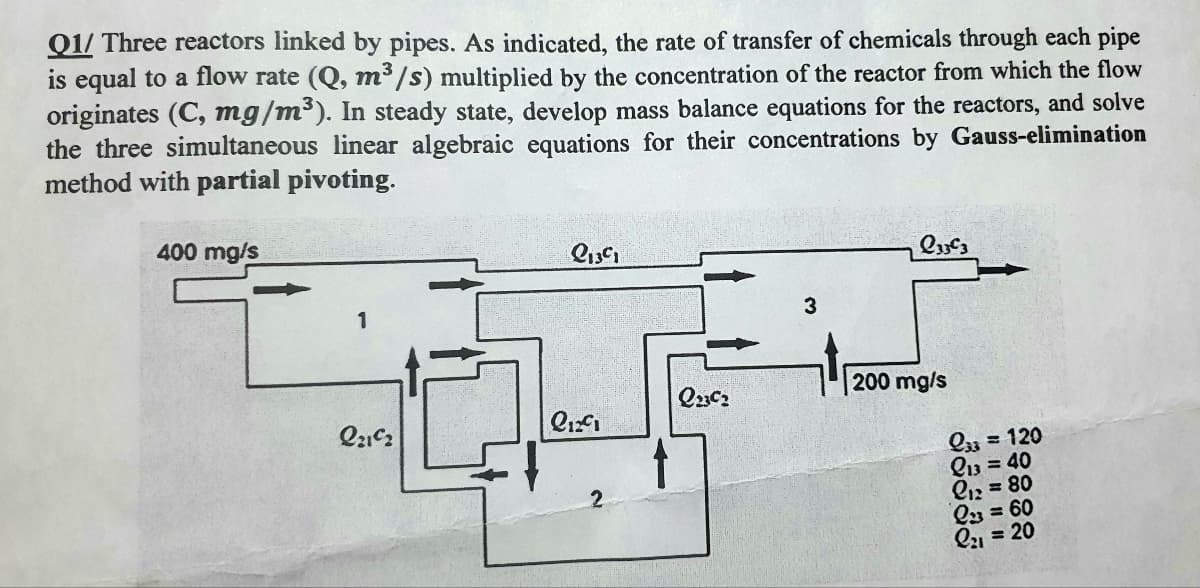Q1/ Three reactors linked by pipes. As indicated, the rate of transfer of chemicals through each pipe is equal to a flow rate (Q, m³/s) multiplied by the concentration of the reactor from which the flow originates (C, mg/m³). In steady state, develop mass balance equations for the reactors, and solve the three simultaneous linear algebraic equations for their concentrations by Gauss-elimination method with partial pivoting. 400 mg/s 221%2 Q13c1 0121 e23c₂ 3 200 mg/s 233= 120 13 = 40 12 = 80 l23 = 60 21 = 20
Q1/ Three reactors linked by pipes. As indicated, the rate of transfer of chemicals through each pipe is equal to a flow rate (Q, m³/s) multiplied by the concentration of the reactor from which the flow originates (C, mg/m³). In steady state, develop mass balance equations for the reactors, and solve the three simultaneous linear algebraic equations for their concentrations by Gauss-elimination method with partial pivoting. 400 mg/s 221%2 Q13c1 0121 e23c₂ 3 200 mg/s 233= 120 13 = 40 12 = 80 l23 = 60 21 = 20
Principles of Heat Transfer (Activate Learning with these NEW titles from Engineering!)
8th Edition
ISBN:9781305387102
Author:Kreith, Frank; Manglik, Raj M.
Publisher:Kreith, Frank; Manglik, Raj M.
Chapter6: Forced Convection Over Exterior Surfaces
Section: Chapter Questions
Problem 6.25P
Related questions
Question

Transcribed Image Text:Q1/ Three reactors linked by pipes. As indicated, the rate of transfer of chemicals through each pipe
is equal to a flow rate (Q, m³/s) multiplied by the concentration of the reactor from which the flow
originates (C, mg/m³). In steady state, develop mass balance equations for the reactors, and solve
the three simultaneous linear algebraic equations for their concentrations by Gauss-elimination
method with partial pivoting.
400 mg/s
221%2
Q1301
1241
2
Q23c₂
3
licz
200 mg/s
233 = 120
13 = 40
12 = 80
23 = 60
21 = 20
Expert Solution
This question has been solved!
Explore an expertly crafted, step-by-step solution for a thorough understanding of key concepts.
Step by step
Solved in 3 steps

Knowledge Booster
Learn more about
Need a deep-dive on the concept behind this application? Look no further. Learn more about this topic, mechanical-engineering and related others by exploring similar questions and additional content below.Recommended textbooks for you

Principles of Heat Transfer (Activate Learning wi…
Mechanical Engineering
ISBN:
9781305387102
Author:
Kreith, Frank; Manglik, Raj M.
Publisher:
Cengage Learning

International Edition---engineering Mechanics: St…
Mechanical Engineering
ISBN:
9781305501607
Author:
Andrew Pytel And Jaan Kiusalaas
Publisher:
CENGAGE L

Principles of Heat Transfer (Activate Learning wi…
Mechanical Engineering
ISBN:
9781305387102
Author:
Kreith, Frank; Manglik, Raj M.
Publisher:
Cengage Learning

International Edition---engineering Mechanics: St…
Mechanical Engineering
ISBN:
9781305501607
Author:
Andrew Pytel And Jaan Kiusalaas
Publisher:
CENGAGE L